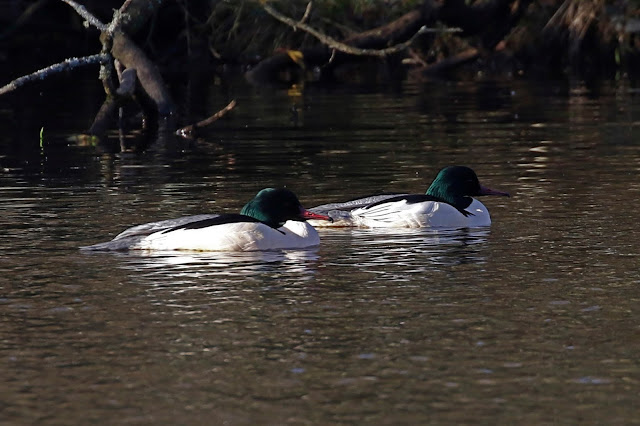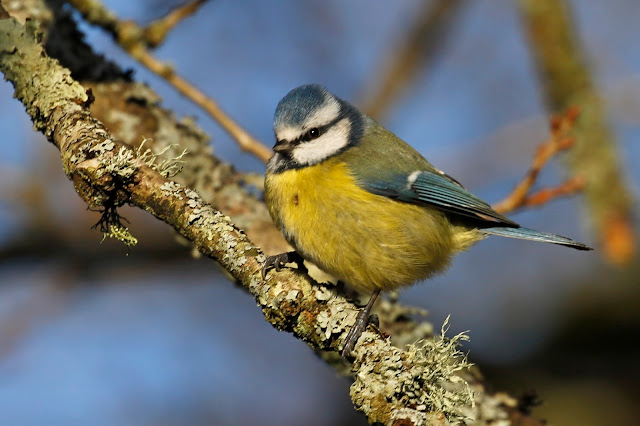A new year once again, and after the celebrations of New
Year’s Eve, and the wet and dismal weather that greeted us when we surfaced
yesterday, today was bright and cold.
One highlight yesterday though was a male Siskin on the feeders in the
garden the first since I removed the feeders due to Trichomonosis back in
September. We decided to head out for a
bank holiday walk, and as we drove away from the house a Red Kite swooped low
over the garden. The destination was to
be the New Forest, specifically Eyeworth Pond.
However what I hadn’t bargained with was the bank holiday visitors to
the New Forest, and as I drove through Fritham past the Royal Oak pub, the tiny
lane was covered in 4x4s, and out along the road were family parties with dogs
and unfolded maps trying to work out where to walk.
Unperturbed I continued on towards the pond, and as we did
the number of cars reduced, there were still plenty of cars in the small pond
car park, but I managed to find a space.
As I got out of the car I could see several Goosander at the back of the
pond, and a single male Mandarin in open water behind the many feeding Mallard.
All kitted out we left the car and stood watching the
water. Several more mandarin appeared,
this time with females. Unfortunately
they do not possess the wonderful plumage of the males, but do still have that
delicate soft look about them.
The Goosander remained at the back of the pond, I could see
three drakes, their creamy white plumage on the breast and body standing out
against the darkness of the pond water, while the bottle green head and neck
would tend to disappear. There were also
about eight red-heads, the term used to identify the female or juvenile
birds. This is probably a female bird
going into adulthood. The adult females
have a solid reddish plumage behind the bill, while the juveniles show a white
stripe leading from the bill to the eye.
The adult female also has a black tip to the bill. Here the bill is almost black.
There were many people around the edge of the pond, the Mallard
benefiting from both the seed put out for the smaller birds, and the lumps of
bread being hurled at them by over generous children. We walked through the wood and headed out
along the main track passing Howen Bottom and heading in the direction of Longcross
Plain. It was one of those typical New
Forest Walks, beautiful light on the birch and bracken, but apart from the odd
Robin or Crow totally devoid of any wildlife.
On reaching the road the path looped back and eventually into the woods
surrounding the pond once again. We came
across a group of Fallow Deer, all stags, and all of different ages. They all possessed antlers, but only one or
two, showed the characteristic palmate antlers that look like giant hands.
The walk had been a short one, but enough to blow away the
cobwebs, and we arrived back at a slightly quieter pond, where the reduced
activity had allowed the Goosander to be a little more approachable. Here a pair in mid water, you can see the full
reddish plumage on the females head
Here two drakes together.
I find male Goosanders extremely difficult to photograph, this is due to
the large panels of contrasting dark green and white which plays havoc with the
exposure, add to this the darkness of the water and it is very trial and error
on what exposure to use.
The mallard were still collecting in front of us, and in the
bushes Blue Tits were busy going from feeders and on to the ground to pick up
the seed left for them. A Kingfisher was
busy fishing on the far side of the pond.
Every so often there would be a flash of blue or orange as it dived into
the water. Finally it flew out of sight
behind the island, where reportedly there was a pair of Wood Duck. Then from beneath the branches of the bushes
on the island a pair of male Mandarin Ducks appeared.
The light was superb, picking out the deep orange of the
whiskers and the “sails” as they quite quickly paddled across the pond in front
of us.
The Mandarin Duck originates from East Asia, and was
introduced into Europe from China, and have become established following
escapes from captivity. In the 20th
century a large feral population was established in Great Britain. It is a perching duck species, and is closely
related to the North American Wood Duck, the only other member of its genus
Aix.
The habitats it prefers in its breeding range are the dense,
shrubby forested edges of rivers and lakes, mostly occurs in low-lying areas,
the surrounding fringes of Eyeworth Pond are ideal for what can be a very
secretive duck. They prefer to feed at
dusk and dawn and can spend considerable amounts of time hidden away in the low
lying branches. They mainly eat seeds,
with beech mast and acorns a favourite during the winter, again Eyeworth
providing plenty for them.
A small group of two males swam out accompanied by two
females, both ducks have crests, the males though being a little more
elaborate. The males also have two
orange “sails” that are elongated tertial feathers in the wings, these are used
in a highly ritualised display that includes raising the crest and sails,
drinking and preening behind the sails.
Here the low sunlight has caught the raised sails as the males swim with
the females.
Two males conducting some synchronised swimming
The camera just wouldn’t stop taking shots.
A small group came closer and I was able to get some shots
through the branches of the trees close to the side of the pond.
But they quickly returned to the open water, the blue sky
reflecting nicely in the ripples of the water
We decided to walk up the road to get a drink at the Royal
Oak. Bizarrely we sat outside on the 2nd
January watching families complain about the benches being wet. When we arrived back at the pond I was
quickly informed by one of the photographers there that the Wood Duck had
appeared from the other side of the island and showed well. Unfortunately they disappeared once again
just before we returned.
Out on the water the Goosander had now moved to the north
eastern corner of the pond, the light again giving good reflections but playing yet again with the exposure.
A female Grey Wagtail flew in behind us and fed around a
small flooded pool in front of the car park.
The Goosander were gathering again at the far side of the
pond, and the Mandarin had gone missing, and while there was no sign of the
Wood Duck my attention turned to the seed scattered around the edge of the pond
and the birds feeding on it. A Marsh Tit
coming very close.
The dominant bird though was the Blue Tit, with many about
squabbling over the rights of certain patches, and then flying into the lichen
covered trees to sit in the afternoon sunshine.
The Coal Tits performed there typical smash and grab raid
technique, moving cautiously through the branches and then dropping quickly to
the pile of seeds and then back up straight away into the tree to eat it.
Back to the water and still no sign of the Wood Duck. The Kingfisher though reappeared and I did
manage to catch it as it flew back and forth from the shore to the island.
The total count of Goosander was twelve redheads, of which
the majority were adult females, and four drakes. Every so often the mallard would have a funny
five minutes and the Goosander would move away into the more open water for
some privacy from the ducks.
Here you can see the clear markings and black bill of the adult female closer.
The cold was now beginning to bite, and I was considering
joining Helen in the car to set off home even though the Wood Duck had not put
in an appearance. I took one final scan
through the branches on the island, at first to try and see the Kingfisher that
had flown, but then I noticed some different white markings on a small duck.
A
continued look finally revealed the drake Wood Duck, and behind it the
female. They never showed any better
than the picture you see above, but it was good enough to ensure I got the
tick.
The last Wood Duck I had seen was in Vancouver, where they are expected to be seen. Like the Mandarin the population here in the UK is here because of escapes. Their numbers are not as widespread as the Mandarin, and they are little more secretive and harder to see.
A
lovely easy day to start the year with some wonderful light and gorgeous
subjects.






















Have you ever consider maximizing your free satoshi claims with a BITCOIN FAUCET ROTATOR?
ReplyDelete